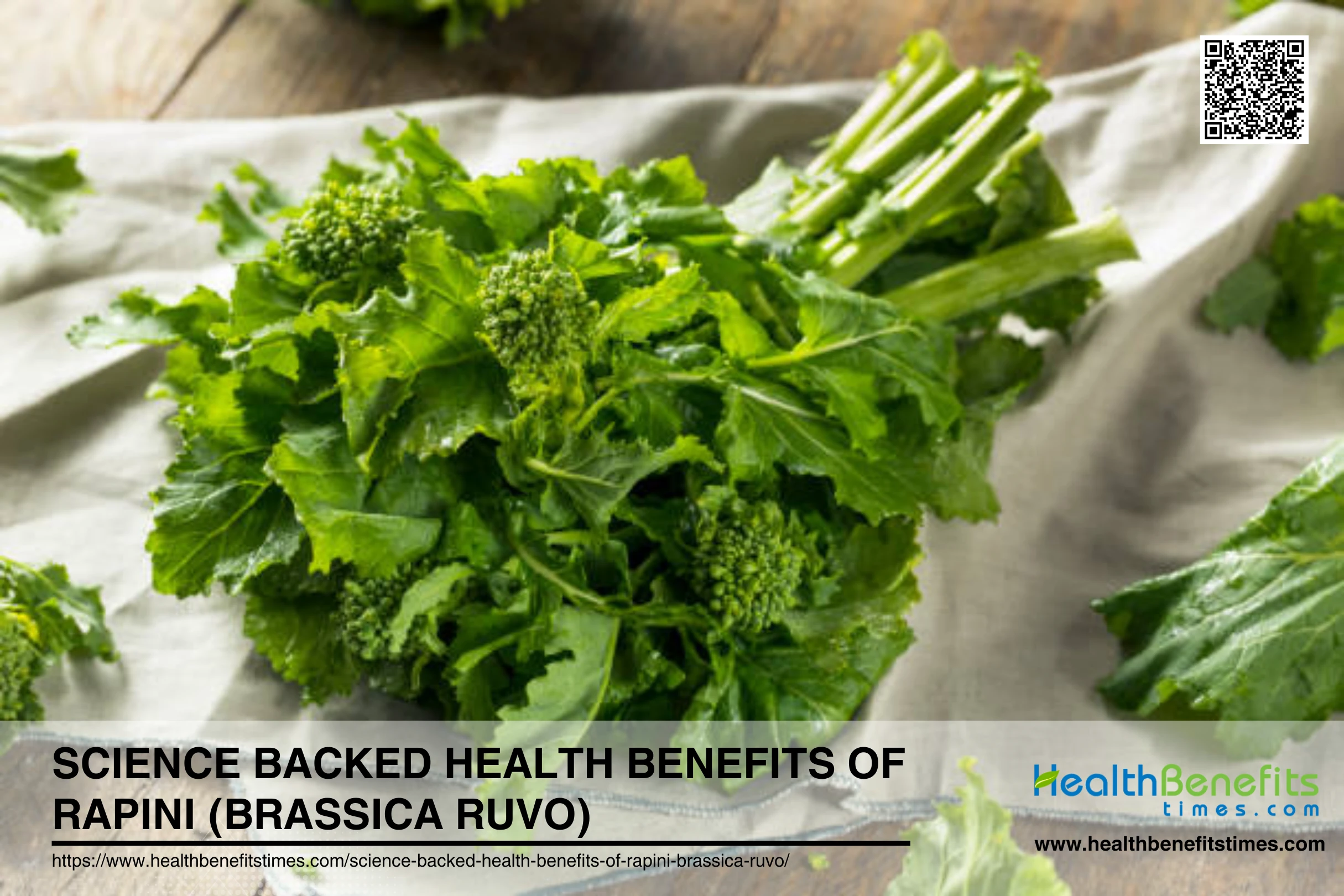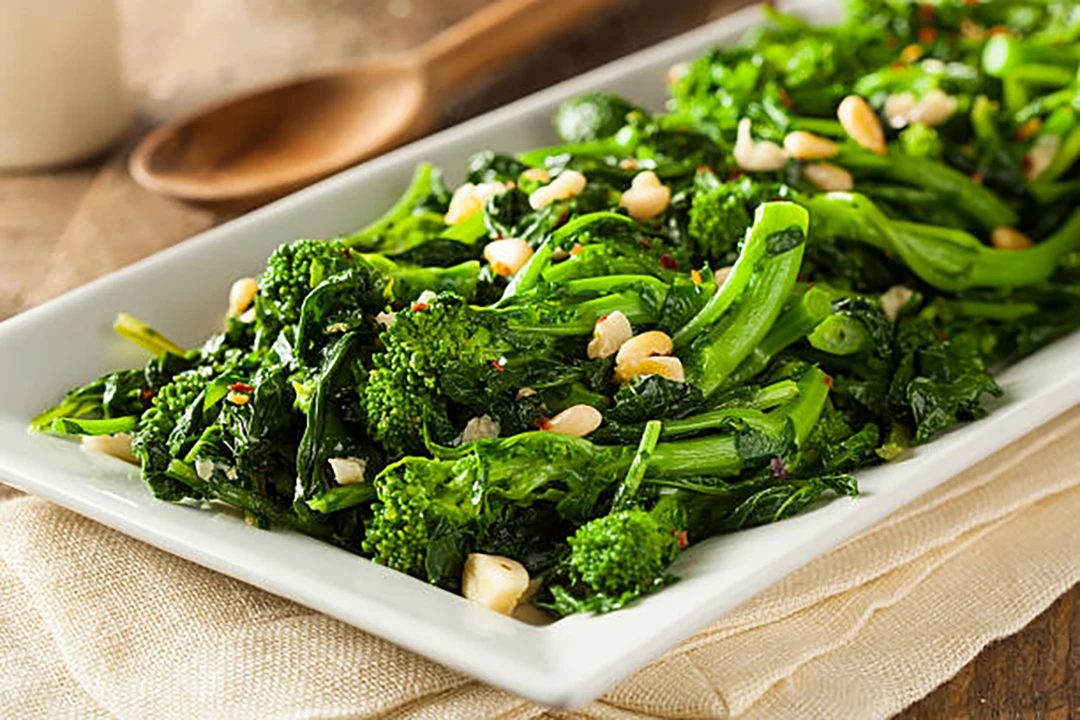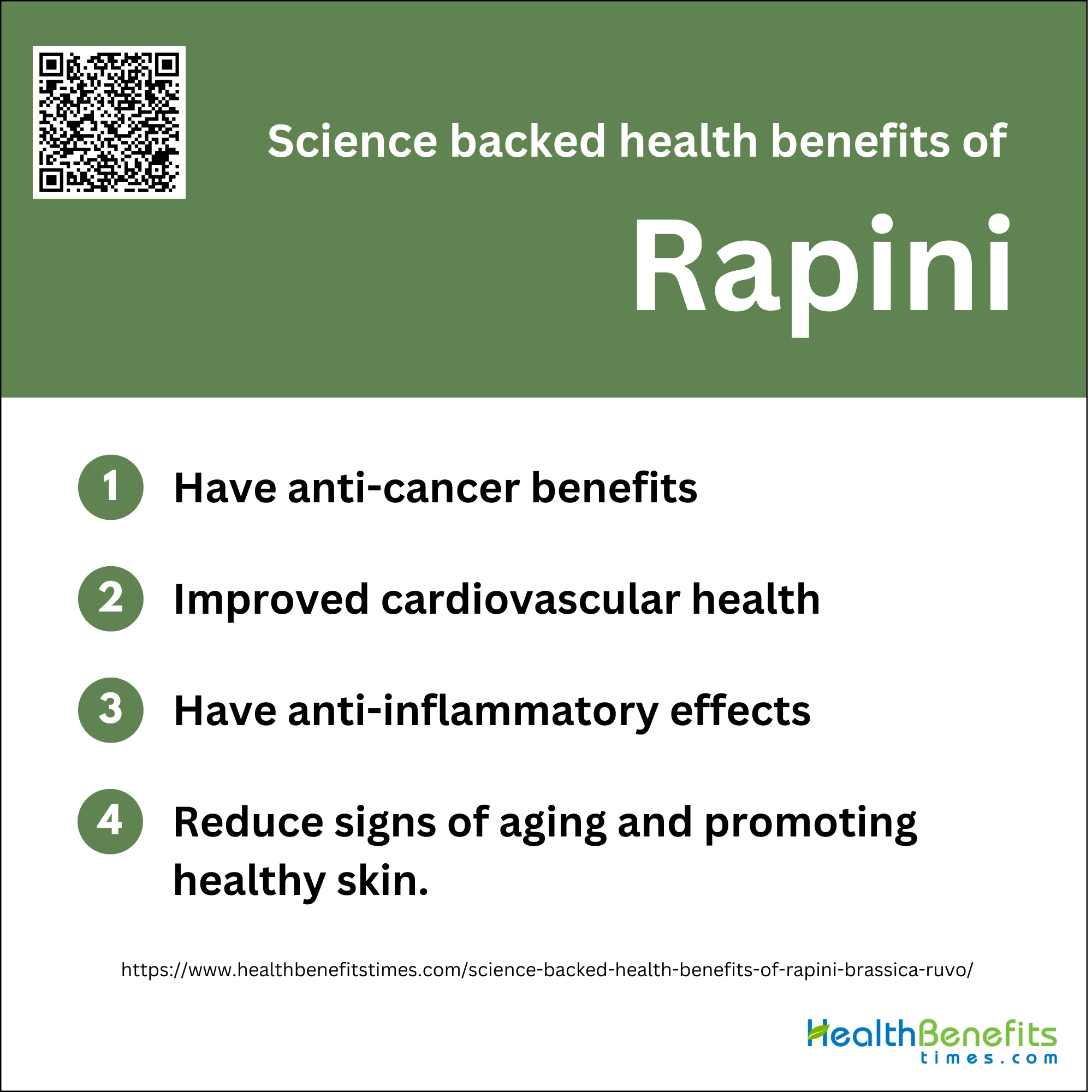- Rapini is nutrient-dense, ecologically beneficial, versatile in microgreens production.
- Rapini, or broccoli rabe, offers significant nutritional and health benefits.
- Rapini has anti-inflammatory properties, promotes healthy skin, and reduces aging signs.
- Rapini is versatile, nutritious, easy to prepare, and pairs well.
- Rapini can interfere with thyroid function, cause digestive issues, interact with blood thinners, trigger allergies, and contain oxalates.
 Rapini, also known as broccoli rabe or Brassica ruvo, is a nutrient-dense cruciferous vegetable that offers a wealth of science-backed health benefits. This leafy green, characterized by its slightly bitter taste and broccoli-like florets, is packed with essential vitamins, minerals, and bioactive compounds that contribute to overall wellness. From supporting heart health and bone strength to potentially reducing cancer risk and boosting the immune system, rapini has garnered attention in the scientific community for its impressive nutritional profile. In this article, we’ll explore the evidence-based health benefits of rapini and why incorporating this versatile vegetable into your diet can be a smart choice for those seeking to optimize their health through nutrition.
Rapini, also known as broccoli rabe or Brassica ruvo, is a nutrient-dense cruciferous vegetable that offers a wealth of science-backed health benefits. This leafy green, characterized by its slightly bitter taste and broccoli-like florets, is packed with essential vitamins, minerals, and bioactive compounds that contribute to overall wellness. From supporting heart health and bone strength to potentially reducing cancer risk and boosting the immune system, rapini has garnered attention in the scientific community for its impressive nutritional profile. In this article, we’ll explore the evidence-based health benefits of rapini and why incorporating this versatile vegetable into your diet can be a smart choice for those seeking to optimize their health through nutrition.
What is Rapini ?
Rapini is a leafy green vegetable that belongs to the Brassicaceae family. It is commonly used in microgreens production due to its nutritional benefits and ease of cultivation. Studies have shown that rapini microgreens can be grown on various substrates, including peat, recycled textile-fiber mats, and jute-kenaf-fiber mats, which offer competitive yields and favorable microbiological quality. Additionally, the use of natural forage such as rapini pollen has been found to improve the health and survival of honey bee colonies compared to protein supplements, highlighting its ecological benefits. Furthermore, incorporating natural materials such as Posidonia oceanica residues into the growing media can enhance the nutritional profile of rapini microgreens, increasing the concentration of essential minerals and bioactive compounds in the edible parts. Overall, rapini is a versatile and valuable crop both for human consumption and ecological sustainability.
Nutritional Profile of Rapini
Rapini is a cruciferous vegetable that is highly regarded for its dense nutritional profile. This leafy green is not only rich in essential vitamins and minerals but also contains significant amounts of dietary fiber and antioxidants. Its low-calorie content makes it an ideal addition to a health-conscious diet. Below, we delve into the specific nutrients that make rapini a powerhouse of health benefits.
Vitamins: High in Vitamins A, C, and K
Rapini is exceptionally high in vitamins A, C, and K, which play crucial roles in maintaining overall health. Vitamin A is vital for good vision, immune function, and skin health, with rapini providing 91% of the daily value per 100g serving. Vitamin C, a potent antioxidant, supports immune health and skin integrity, offering 62% of the daily value per 100g. Vitamin K is essential for blood clotting and bone health, with rapini delivering an impressive 320% of the daily value per 100g.
Minerals: Rich in Calcium, Iron, and Potassium
In addition to its vitamin content, rapini is rich in essential minerals such as calcium, iron, and potassium. Calcium is crucial for bone and teeth health, with rapini providing 12% of the daily value per 100g. Iron is important for oxygen transport in the blood, and rapini offers 12.7% of the daily value per 100g. Potassium helps regulate blood pressure and supports heart and muscle function, with rapini containing 7.3% of the daily value per 100g.
Other Nutrients: Contains Fiber, Folate, and Antioxidants
Rapini is also a good source of dietary fiber, folate, and various antioxidants. The fiber content aids in digestive health and helps maintain a feeling of fullness, with 2.7g per 100g serving. Folate is essential for cell growth and development, particularly important for pregnant women, with rapini providing 18% of the daily value per 100g. Additionally, rapini contains antioxidants like glucosinolates and sulforaphane, which have anti-inflammatory and potential cancer-fighting properties.
Caloric Information: Low-Calorie Content
One of the most appealing aspects of rapini is its low-calorie content, making it an excellent choice for those looking to maintain or lose weight. With only 22-33 calories per 100g of raw rapini, it provides a wealth of nutrients without significantly impacting daily calorie goals. This low-calorie, nutrient-dense profile allows individuals to incorporate rapini into their meals generously, reaping its health benefits without concern for excessive calorie consumption.
Science backed health benefits of Rapini
Rapini is a cruciferous vegetable celebrated for its robust nutritional profile and myriad health benefits. This leafy green is not only a culinary delight but also a powerhouse of essential vitamins, minerals, and antioxidants. In this listicle, we will explore the science-backed health benefits of rapini, shedding light on why this vegetable deserves a prominent place in your diet. From its potential to reduce cancer risk and support heart health to its role in boosting bone strength and enhancing immune function, rapini offers a wide range of advantages that are supported by scientific research. Dive in to discover how incorporating rapini into your meals can contribute to a healthier, more vibrant life.
1. Have anti-cancer benefits
Rapini offers significant benefits for bone health due to its rich nutrient profile. This cruciferous vegetable is an excellent source of vitamin K, providing up to 320% of the daily value per 100g serving. Vitamin K plays a crucial role in bone metabolism and may help reduce the risk of osteoporosis. Additionally, rapini contains a substantial amount of calcium, with 118 mg per 100g (about 12% of the daily value), which is essential for building and maintaining strong bones. The combination of vitamin K and calcium in rapini works synergistically to support optimal bone health. Furthermore, rapini provides other bone-supporting nutrients such as magnesium, potassium, and vitamin C, which contribute to overall bone strength and density. Regular consumption of rapini as part of a balanced diet can contribute to improved bone health and may help prevent bone-related disorders.
What Research Says?
- RAP mixed with MEL works better to stop and treat weak bones than just MEL. This mix makes bones denser, stronger, and helps control genes linked to the OPG/RANKL pathway.
- Taking a drink with vitamin D, calcium, and leucine-rich whey protein can raise vitamin D levels in the blood. It also lowers parathyroid hormone (PTH) and slightly boosts bone density in older adults who have sarcopenia but are not malnourished.
2. Improved cardiovascular health

Rapini is highly beneficial for cardiovascular health due to its rich content of essential nutrients and bioactive compounds. This cruciferous vegetable is packed with antioxidants like vitamin C, which helps reduce oxidative stress and inflammation, both of which are key factors in heart disease. Additionally, rapini contains significant amounts of folate, which plays a crucial role in reducing homocysteine levels in the blood—a known risk factor for cardiovascular issues. The high potassium content in rapini aids in regulating blood pressure by counteracting the effects of sodium and relaxing blood vessel walls. Furthermore, the fiber in rapini helps lower cholesterol levels by binding to bile acids and removing them from the body, thereby reducing the risk of atherosclerosis. Regular consumption of rapini can thus contribute to improved heart health and reduced risk of cardiovascular diseases.
What Research Says?
- Vegetables from the Brassicaceae family, like Brassica ruvo, have lots of vitamins (like carotenoids, tocopherol, and vitamin C), minerals (like copper, zinc, and magnesium), and different plant chemicals (like glucosinolates and phenolics). These nutrients help make them good for your health.
- The healthy substances in Brassicaceae, like antioxidants and glucosinolates, help protect the heart. They reduce stress and swelling in the body, which are important in heart diseases.
3. Have anti-inflammatory effects
Rapini possesses significant anti-inflammatory properties that contribute to its overall health benefits. This cruciferous vegetable contains a variety of compounds that work together to reduce inflammation in the body. Notably, rapini is rich in omega-3 and omega-6 fatty acids, which are known for their anti-inflammatory effects. These fatty acids help combat chronic inflammation, which is linked to various health issues including cardiovascular disease and cancer. Additionally, rapini contains powerful antioxidants such as vitamin C and flavonoids that neutralize free radicals and reduce oxidative stress, further contributing to its anti-inflammatory action. The vegetable also contains glucosinolates, which break down into isothiocyanates – compounds that have been shown to have anti-inflammatory properties.
What Research Says?
- Substances from Raphanus sativus seeds, mainly 4-methylthio-butanyl types, greatly block the making of nitric oxide. They also lower how much inducible nitric oxide synthase (iNOS) is made in mouse microglia BV2 cells triggered by lipopolysaccharide (LPS).
- The ethyl acetate part from Raphanus sativus seeds greatly reduces the making of nitric oxide, interleukin-6 (IL-6), and tumor necrosis factor-alpha (TNF-α) in cells when they are stimulated by LPS.
4. Reduce signs of aging and promoting healthy skin.

This cruciferous vegetable is rich in vitamins A, C, and K, all of which play crucial roles in skin health. Vitamin A promotes the growth of new skin cells, helping to maintain a fresh and youthful appearance. Vitamin C is essential for collagen production, which keeps the skin firm and elastic, reducing the appearance of wrinkles and fine lines. Additionally, vitamin K helps reduce dark circles under the eyes by improving blood circulation. Rapini is also packed with antioxidants, such as lutein and beta-carotene, which protect the skin from oxidative stress and UV damage, further preventing premature aging. The high water content in rapini helps keep the skin hydrated, while its anti-inflammatory properties reduce redness and irritation, contributing to a clearer and more vibrant complexion. Regular consumption of rapini can thus support healthy, youthful skin and help mitigate the visible effects of aging.
What Research Says?
- Plants in the Brassicaceae family, like Brassica ruvo, have strong anti-inflammatory and antioxidant effects. These are key for keeping skin healthy and slowing down signs of aging.
- Extracts from Brassica chinensis, a related plant, have shown better antioxidant activity and anti-aging effects in lab studies and live models like Caenorhabditis elegans. These extracts made the organisms stronger against oxidative stress and helped them live longer. This suggests they might help with anti-aging.
How to Incorporate Rapini into Your Diet
Incorporating rapini into your diet is easy and versatile, thanks to its unique flavor and nutritional benefits. This leafy green can be used in a variety of dishes, from simple sautés to complex pasta recipes. One popular way to enjoy rapini is to sauté it with garlic and olive oil, which helps mellow its natural bitterness and brings out its rich, earthy flavors. You can also add rapini to soups, stews, and casseroles for an extra nutrient boost. For a quick and healthy meal, toss blanched rapini with pasta, lemon juice, and Parmesan cheese. Its slightly bitter taste pairs well with rich ingredients like cheese, nuts, and cured meats, making it a versatile addition to many dishes. Whether you’re looking to enhance the nutritional profile of your meals or simply enjoy a new vegetable, rapini is a fantastic choice.
Easy Recipes and Cooking Tips
Rapini is incredibly versatile and can be prepared in numerous ways to suit different tastes and cuisines. One easy recipe is to sauté rapini with garlic, red pepper flakes, and olive oil until tender, then finish with a squeeze of lemon juice. This simple preparation highlights the vegetable’s natural flavors and makes a great side dish. For a heartier meal, try adding rapini to pasta dishes; blanch it first to reduce bitterness, then toss with cooked pasta, Italian sausage, and a sprinkle of Parmesan cheese. Another delicious option is to incorporate rapini into stir-fries with ginger, soy sauce, and a touch of sugar to balance its bitterness. When cooking rapini, remember to trim the tough ends of the stems and blanch the greens briefly in boiling water to soften their texture and reduce bitterness. These tips and recipes make it easy to enjoy the health benefits of rapini in your everyday meals.
Suggestions for Pairing with Other Foods
Rapini pairs exceptionally well with a variety of foods, enhancing both flavor and nutritional value. Its slightly bitter taste complements rich, savory ingredients like Italian sausage, pancetta, and bacon, making it a perfect addition to pasta dishes and casseroles. For a balanced meal, try pairing rapini with creamy cheeses such as ricotta or mozzarella, which help mellow its bitterness. It also works well with legumes like white beans and chickpeas, adding a hearty texture and earthy flavor to soups and stews. In Asian-inspired dishes, rapini can be stir-fried with garlic, ginger, and soy sauce, and served over rice or noodles. For a fresh and vibrant salad, combine blanched rapini with citrus fruits, nuts, and a light vinaigrette. These pairings not only enhance the taste of rapini but also create well-rounded, nutritious meals.
Tips for Buying and Storing Rapini
When buying rapini, look for bunches with firm, dark green leaves and tightly closed florets, avoiding any with yellowing or wilting leaves, as these are signs of age and reduced freshness. The stems should be firm and free from any slimy or mushy spots. Once you’ve selected your rapini, proper storage is key to maintaining its freshness. Store unwashed rapini in a closed perforated bag in the crisper drawer of your refrigerator, where it will stay fresh for three to four days. If you need to store it longer, you can blanch the rapini for three minutes, then freeze it on a tray before transferring it to freezer bags or containers; this method preserves its nutritional value and flavor for up to 12 months, although the texture may change slightly. By following these tips, you can ensure that your rapini remains fresh and ready to use in a variety of delicious dishes.

Side effects of consuming rapini
Based on the search results provided, here are individual paragraphs on potential side effects of consuming rapini:
Thyroid Function Interference
Rapini, like other cruciferous vegetables, contains goitrogens, which are compounds that can interfere with thyroid function. These substances may suppress the thyroid gland’s ability to utilize iodine effectively, potentially leading to an enlarged thyroid (goiter) or other thyroid-related issues. However, this is primarily a concern for individuals with existing thyroid problems or those consuming excessive amounts of raw rapini.
Digestive Discomfort
Due to its high fiber content and the presence of certain compounds, rapini may cause digestive issues in some individuals. This can include bloating, gas, and abdominal discomfort, especially when consumed in large quantities or by those with sensitive digestive systems. The cruciferous nature of rapini contributes to its potential to cause gastric issues and bloating in some people.
Interaction with Blood Thinners
Rapini is rich in vitamin K, which plays a crucial role in blood clotting. For individuals taking blood-thinning medications like warfarin, consuming large amounts of rapini may interfere with the effectiveness of these drugs. It’s important for people on blood thinners to maintain consistent vitamin K intake and consult with their healthcare provider about incorporating rapini into their diet.
Potential for Allergic Reactions
While rare, some individuals may experience allergic reactions to rapini. As with any food, it’s possible to develop an allergy to rapini, which could manifest as symptoms ranging from mild (such as itching or hives) to severe (such as difficulty breathing or anaphylaxis). Those with known allergies to other cruciferous vegetables should exercise caution when trying rapini for the first time.
Oxalate Content Concerns
Rapini contains oxalates, which can be problematic for individuals prone to kidney stones or those with a history of oxalate-related issues. High oxalate intake can contribute to the formation of kidney stones in susceptible individuals. Therefore, people with a history of kidney stones or those advised to follow a low-oxalate diet should be cautious about their rapini consumption.
Conclusion
In conclusion, rapini is a nutritional powerhouse that offers numerous health benefits, including potential anti-cancer properties, improved cardiovascular health, anti-inflammatory effects, and skin health support. This cruciferous vegetable is rich in essential vitamins, minerals, and antioxidants, making it a valuable addition to a balanced diet. While rapini can be easily incorporated into various dishes and offers versatile culinary applications, it’s important to be aware of potential side effects, particularly for individuals with thyroid issues, those on blood thinners, or those prone to digestive discomfort. As with any dietary change, moderation is key, and consulting with a healthcare provider is advisable, especially for those with pre-existing health conditions. Overall, when consumed as part of a varied and balanced diet, rapini can contribute significantly to overall health and well-being.
ADDITIONAL RESOURCES
Here are some US organizations involved in vegetable research along with their short descriptions and URLs:
1. Oklahoma State University – Department of Horticulture and Landscape Architecture
This department conducts extensive research on vegetable crop production, including field trials and studies on crop responses and yield data. They provide valuable insights into effective horticultural practices and innovations in vegetable farming.
2. USDA Agricultural Research Service (ARS)
The USDA ARS conducts research on dark green leafy vegetables, focusing on their nutritional benefits and role in preventing diseases. Their work includes studying the impact of these vegetables on metabolism and overall health.
3. MyPlate – USDA Center for Nutrition Policy and Promotion (CNPP)
MyPlate offers resources and guidelines to promote healthy eating habits, emphasizing the importance of incorporating vegetables into the diet. They provide recipes and nutritional information to help consumers make informed food choices.
Recommendations for books on rapini
Here are some recommended books on the research and culinary uses of rapini:
1. “Orecchiette with Broccoli Rabe (Rapini) from Puglia” by The Pasta Project
This book delves into traditional Italian recipes featuring rapini, offering detailed cooking methods and tips to bring out the best flavors of this vegetable.
2. “Sauteed Broccoli Rabe {Rapini}” by Italian Recipe Book
This book provides various recipes and preparation techniques for rapini, focusing on its use in Italian cuisine, including tips on reducing its bitterness.
FAQS
- What are the primary nutrients found in rapini?
Rapini, also known as broccoli rabe, is rich in essential vitamins and minerals, including vitamins A, C, and K, calcium, iron, and potassium. It also contains dietary fiber and various antioxidants such as glucosinolates and sulforaphane.
- How does rapini contribute to cancer prevention?
Rapini contains glucosinolates, which break down into biologically active compounds like isothiocyanates and indoles during digestion. These compounds have been shown to have anticancer properties, helping to prevent the development of cancer-causing cells.
- Can rapini help with weight management?
Yes, rapini is low in calories and high in dietary fiber, which can help promote satiety and reduce overall calorie intake. Additionally, it may influence the gut microbiome by increasing beneficial bacteria, which is linked to a leaner body mass.
- What are the benefits of rapini for bone health?
Rapini is an excellent source of vitamin K, which plays a crucial role in bone health by promoting osteoblastic activity and helping to maintain bone density. It also contains calcium, which is essential for strong bones.
- How does rapini support cardiovascular health?
Rapini is rich in potassium, which helps regulate blood pressure, and folate, which reduces homocysteine levels, a risk factor for heart disease. Its antioxidants also help reduce inflammation and oxidative stress, contributing to overall heart health.
- Can rapini improve digestive health?
Yes, rapini’s high fiber content aids in digestion by promoting regular bowel movements and preventing constipation. Fiber also supports a healthy gut microbiome, which is essential for overall digestive health.
- What role does rapini play in diabetes management?
Rapini’s high fiber content can help regulate blood sugar levels by slowing down the absorption of sugar into the bloodstream. This can prevent spikes in blood glucose and improve insulin sensitivity.
- How does rapini benefit pregnant women?
Rapini is a good source of folate (vitamin B9), which is essential for preventing neural tube defects in developing fetuses. It also supports the production of new cells, making it particularly important during pregnancy.
- Are there any anti-inflammatory benefits associated with rapini?
Yes, rapini contains various antioxidants and phytochemicals that have anti-inflammatory properties. These compounds help reduce inflammation in the body, which can lower the risk of chronic diseases.
- How can rapini be incorporated into a diet?
Rapini can be enjoyed in various ways, including sautéed with garlic and olive oil, added to soups and stews, or used as a side dish. Blanching rapini can reduce its bitterness, making it more palatable for those who prefer a milder taste.


